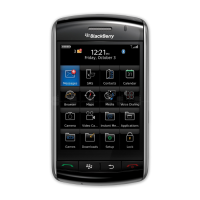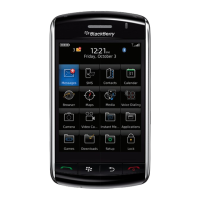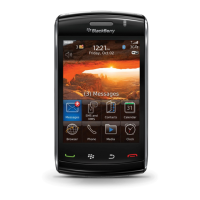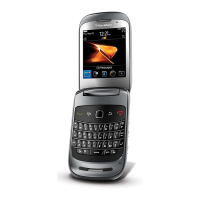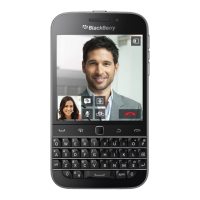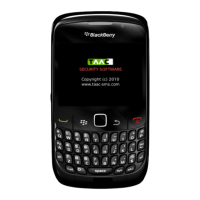Do you have a question about the Blackberry Storm 9530 and is the answer not in the manual?
Discusses factors influencing feature availability on your BlackBerry device.
Guides you through initial device setup, including navigation and connections.
Explains how to navigate screens and perform basic typing operations.
Provides step-by-step instructions on how to initiate phone calls.
Instructions for composing and sending email messages from your device.
Steps to send short text messages to multiple recipients.
Guide on how to add new contact information to your device.
How to create and manage calendar appointments and meetings.
Instructions for using the device's camera to capture photos.
Guide on how to use the video camera function to record videos.
Instructions on how to access and browse websites using the device's browser.
Steps to connect your device wirelessly with other Bluetooth devices.
Common issues and solutions for basic device operations.
Explains shortcuts for core device functions and navigation.
Shortcuts related to making calls, managing ringtones, and speed dial.
Shortcuts to expedite text input and character entry.
Shortcuts for controlling audio, video playback, and camera functions.
Solutions for issues related to using device shortcuts.
Fundamental operations related to phone functionality, like finding your number.
Detailed steps for initiating phone calls.
How to receive and answer incoming phone calls.
Adjusting the device's volume levels for calls and media.
Managing voice mail greetings and accessing voice mail.
Setting up and using speed dial for quick calling.
How to set up and manage conference calls.
Viewing and managing call history and logs.
How to enable and manage call waiting features.
Setting up and managing call forwarding options.
How to block unwanted incoming or outgoing calls.
Configuring and using fixed dialling lists for restricted calls.
Setting up smart dialling for country codes and extensions.
Managing multiple phone numbers associated with the device.
Various settings for customizing phone behavior and appearance.
Solutions for common phone-related issues and errors.
Fundamental operations for composing and managing messages.
Instructions for sending email, SMS, and MMS messages.
How to open, save, search, and delete messages.
Specifics on sending, filing, and managing email messages.
Setting up rules to manage incoming email messages.
Using flags for follow-up reminders and message organization.
Configuring settings for email display, notifications, and replies.
Sending and managing PIN messages for BlackBerry devices.
Sending and managing SMS text messages.
Sending and managing multimedia messages.
Attaching various file types to MMS messages.
Settings for MMS delivery notifications and message blocking.
Customizing how messages are displayed and managed in lists.
Securing messages using S/MIME for encryption and digital signatures.
Securing messages using PGP for encryption and digital signatures.
Resolving issues related to sending, receiving, or displaying messages.
Understanding how to view, download, and manage files and attachments.
Viewing properties, renaming, deleting, and moving files.
Working with document files, including opening password-protected PDFs.
Features for working with spreadsheet files on the device.
Viewing and managing various media file types like .tif.
Handling vCard attachments for contact information.
Resolving issues with files and attachments not appearing or displaying correctly.
Playing, managing, and adjusting volume for audio and video files.
Creating and managing standard and automatic music playlists.
Using the device's camera to record videos.
Features for taking pictures, adjusting size, quality, and storage.
Renaming, moving, deleting, and viewing properties of media files.
Managing device memory and media cards, including formatting.
Connecting to a computer to transfer and sync media files.
Resolving issues with playing media files and device recognition.
Fundamental browser operations like visiting and searching web pages.
Adding, changing, and managing bookmarks for web pages.
Subscribing to and viewing web feed content.
Customizing browser settings like home page, fonts, and display.
Understanding and configuring browser security protocols like TLS and SSL.
Managing push notifications from web applications.
Resolving issues with browser functionality and connection problems.
How to manually set the device's date and time.
Automatically updating time and date via the wireless network.
Setting and managing alarms for timely alerts.
Instructions for using the device's stopwatch function.
How to set and use the countdown timer feature.
Resolving issues with incorrect device time or time zone settings.
Managing contact information, including adding and editing.
Setting specific ringtones for individual contacts.
Creating and managing mailing lists for group messaging.
Managing contacts from multiple accounts or lists.
Customizing how contacts are displayed and sorted.
Resolving issues with contact data synchronization and display.
Navigating and understanding different calendar views.
Creating and managing appointments and meetings.
Steps to schedule meetings, including inviting attendees.
Setting alarms for reminders and specific times.
How to accept, decline, or delegate meeting invitations.
Checking when meeting attendees are available.
Creating and managing conference calls through the calendar.
Customizing calendar views, reminders, and start/end times.
Resolving issues with scheduling, synchronization, and character display.
Creating and managing tasks, including setting due dates and recurrence.
Editing existing task details and status.
Removing tasks from the device.
Customizing the display and sorting of tasks.
Creating, changing, and sending memo notes.
Removing memos from the device.
Customizing memo list display and deletion prompts.
Organizing contacts, tasks, and memos using categories.
Steps to create new categories for organization.
Sorting items based on their assigned categories.
Removing unused categories.
Utilizing the device's calculator functionality, including landscape mode.
Performing unit conversions within the calculator.
Understanding how sound profiles manage alerts for calls and messages.
Setting custom ringtones for the device.
Selecting different sound profiles for alerts.
Creating personalized sound profiles for alerts.
Setting specific ringtones for individual contacts.
Understanding the function and colors of the device's LED indicator.
Resolving issues with device ringing or vibrating behavior.
Essential text manipulation functions like cut, copy, paste, and clearing fields.
Inputting accented and special characters.
Switching between different keyboard layouts like SureType and full keyboard.
Understanding SureType and multi-tap typing methods.
Customizing keyboard layout, cursor speed, and key tones.
Checking spelling in various applications and customizing suggestions.
Managing personal words and phrases for the spelling checker.
Using and creating AutoText entries for quick text replacement.
Resolving issues with typing, word recognition, and spelling.
Setting the device's display language.
Selecting the language for typing input.
Customizing how contact names appear across applications.
Resolving issues with character display and voice command language.
Adjusting screen brightness and timeout settings.
Customizing visual aspects like wallpaper and font.
Setting a custom image as the device wallpaper.
Modifying the font style and size for device text.
Managing application icons and folders on the Home screen.
Configuring keyboard settings like key tones and cursor speed.
Customizing the function of device convenience keys.
Customizing device appearance using themes.
Applying different visual themes to the device.
Removing downloaded themes from the device.
Searching for messages, attachments, and web content.
Specifying criteria to find messages across different accounts.
Defining parameters like type, name, subject, and message body for searches.
Handling search results, including viewing, adding, and deleting.
Searching for contacts and other organiser data.
Locating contacts within an organizational address book.
Overview of synchronizing organiser data and email messages.
Synchronizing email messages between the device and computer.
Removing email messages from both device and computer.
How to sync contacts, calendar, tasks, and memos wirelessly.
Understanding and resolving conflicts during data synchronization.
Procedures for backing up and restoring device data.
Securely wiping all device data, apps, or media card contents.
Solutions for issues with email reconciliation and organiser synchronization.
Introduction to Bluetooth technology and its capabilities.
Enabling and disabling Bluetooth connectivity on the device.
Steps to establish a wireless connection with Bluetooth devices.
Connecting to already paired Bluetooth devices.
Receiving media files wirelessly via Bluetooth.
Transmitting media files to other Bluetooth devices.
Configuring various Bluetooth profiles and settings.
Making the device visible for Bluetooth pairing.
Enabling data encryption for Bluetooth communications.
Resolving issues with Bluetooth passkeys, device pairing, and sharing.
Understanding GPS functionality for location services.
Obtaining the device's current GPS location.
Disabling location aiding to potentially reduce data charges.
Managing location tracking permissions for privacy.
Resolving issues with GPS technology usage.
Core map functions like getting directions and viewing locations.
Obtaining driving directions to specified locations.
Visualizing directions as a route on the map interface.
Finding and viewing specific locations on the map.
Searching for nearby places like businesses or landmarks.
Recording and viewing your travel path using GPS.
Controlling map zoom and direction views.
Saving and managing frequently visited locations or routes.
Configuring GPS source and clearing map cache.
Understanding how to run multiple applications simultaneously.
Switching between active applications efficiently.
Properly closing applications to optimize device performance.
Finding and downloading new applications from BlackBerry App World.
Using messaging apps like BlackBerry Messenger.
Managing application versions via the application centre.
Removing applications not pre-installed on the device.
Finding and installing updates for device applications.
Resolving issues with application installation and functionality.
Reasons for updating the device's operating system software.
Performing software updates wirelessly via the device.
Downgrading device software to a previous version.
Manually checking for available wireless software updates.
Step-by-step guide to updating software from a website.
Solutions for issues with wireless software updates.
Establishing a connection to the wireless network.
Disconnecting from the wireless network for specific situations.
Managing data services and roaming settings.
Information on supported wireless network types.
Enabling LED notifications for wireless network status.
Checking the current status of network connections.
Manually selecting preferred wireless networks.
Managing the list of preferred wireless networks.
Resolving issues with wireless network connectivity and synchronization.
Procedures for powering down the device.
Tips and settings to conserve battery power.
Erasing and preparing storage for device memory or media cards.
Guidelines for managing device memory to maintain performance.
Troubleshooting low application memory issues.
Accessing and managing contacts stored on the SIM card.
Saving contact information directly to the SIM card.
Transferring SIM card contacts to the device's contact list.
Saving SMS messages directly onto the SIM card.
Protecting the SIM card with security features like PIN codes.
Enabling and setting a PIN code for SIM card security.
Modifying the existing SIM card PIN code.
Understanding fundamental security features like device passwords.
Enabling and configuring a password for device security.
Manually locking the device screen for security.
Securely wiping all device data, apps, or media card contents.
Storing and managing passwords securely.
Securing device data through encryption methods.
Enabling encryption for device memory and media cards.
Automatically deleting sensitive temporary data.
Enabling the feature to clean temporary memory.
Managing digital certificates for authentication and security.
Obtaining certificates from LDAP or DSML servers.
Details on revocation status, trust status, and expiration dates.
Verifying if a certificate or its chain has been revoked.
Revoking a certificate's trust on the device.
Customizing certificate display names and email associations.
Managing PGP keys for secure communication.
Obtaining PGP keys from LDAP servers.
Customizing PGP key display names and fetch status prompts.
Managing connections to LDAP and DSML certificate servers.
Managing the device's key store for certificates and PGP keys.
Using smart cards for storing certificates and authentication.
Enhancing security with two-factor authentication methods.
Enabling two-factor authentication for device security.
Authenticating the smart card using a certificate.
Using software tokens for VPN login and security.
Configuring VPN profiles and connection settings.
Connecting to a virtual private network.
Managing permissions for third-party applications.
Setting permissions for third-party apps to access Email, Organiser Data, Files, Security Data.
Resolving issues with certificate downloads and device unlock methods.
Managing service books that determine available device services.
Running, viewing, and submitting diagnostic reports.
Troubleshooting issues with running or submitting diagnostic reports.
Overview of features for users with disabilities.
Enabling closed captions for video playback.
Customizing the font style and size for device text.
Applying reverse contrast for improved screen visibility.
Enabling greyscale mode for screen display.
Setting custom ringtones and alerts for specific contacts.
Using the device with TTY devices for text-based communication.
Activating hearing aid compatibility mode for audio enhancement.
Making calls using voice commands.
Using and creating AutoText entries for text replacement.
Introduction to the BrickBreaker game and its objectives.
Explains the various capsules and their effects in the game.
Instructions on how to control the paddle and shoot in the game.
Uploading game scores to a web-based high score list.
Introduction to the Word Mole game and its objectives.
Steps to form words by selecting letters in the game.
Explains scoring mechanics, word length, letter usage, and bonus points.
Options for playing single-player games, including tutorial and saving.
Setting up and playing games with other players.
Resolving issues with multiplayer game connectivity and invitations.
Definition of Abbreviated Dialling Number.
Definition of Access Point Name.
Definition of Blind Carbon Copy.
Definition of devices with BlackBerry capabilities.
Definition of BlackBerry Mobile Data System.
Definition of a digital document binding identity and public key.
Definition of Code Division Multiple Access.
Definition of Global Positioning System.
Definition of Multimedia Messaging Service.
Definition of a PGP key made of public and private keys.
Definition of personal identification number.
Definition of Secure Multipurpose Internet Mail Extensions.
Definition of Transport Layer Security.
Definition of virtual private network.
Discusses factors influencing feature availability on your BlackBerry device.
Guides you through initial device setup, including navigation and connections.
Explains how to navigate screens and perform basic typing operations.
Provides step-by-step instructions on how to initiate phone calls.
Instructions for composing and sending email messages from your device.
Steps to send short text messages to multiple recipients.
Guide on how to add new contact information to your device.
How to create and manage calendar appointments and meetings.
Instructions for using the device's camera to capture photos.
Guide on how to use the video camera function to record videos.
Instructions on how to access and browse websites using the device's browser.
Steps to connect your device wirelessly with other Bluetooth devices.
Common issues and solutions for basic device operations.
Explains shortcuts for core device functions and navigation.
Shortcuts related to making calls, managing ringtones, and speed dial.
Shortcuts to expedite text input and character entry.
Shortcuts for controlling audio, video playback, and camera functions.
Solutions for issues related to using device shortcuts.
Fundamental operations related to phone functionality, like finding your number.
Detailed steps for initiating phone calls.
How to receive and answer incoming phone calls.
Adjusting the device's volume levels for calls and media.
Managing voice mail greetings and accessing voice mail.
Setting up and using speed dial for quick calling.
How to set up and manage conference calls.
Viewing and managing call history and logs.
How to enable and manage call waiting features.
Setting up and managing call forwarding options.
How to block unwanted incoming or outgoing calls.
Configuring and using fixed dialling lists for restricted calls.
Setting up smart dialling for country codes and extensions.
Managing multiple phone numbers associated with the device.
Various settings for customizing phone behavior and appearance.
Solutions for common phone-related issues and errors.
Fundamental operations for composing and managing messages.
Instructions for sending email, SMS, and MMS messages.
How to open, save, search, and delete messages.
Specifics on sending, filing, and managing email messages.
Setting up rules to manage incoming email messages.
Using flags for follow-up reminders and message organization.
Configuring settings for email display, notifications, and replies.
Sending and managing PIN messages for BlackBerry devices.
Sending and managing SMS text messages.
Sending and managing multimedia messages.
Attaching various file types to MMS messages.
Settings for MMS delivery notifications and message blocking.
Customizing how messages are displayed and managed in lists.
Securing messages using S/MIME for encryption and digital signatures.
Securing messages using PGP for encryption and digital signatures.
Resolving issues related to sending, receiving, or displaying messages.
Understanding how to view, download, and manage files and attachments.
Viewing properties, renaming, deleting, and moving files.
Working with document files, including opening password-protected PDFs.
Features for working with spreadsheet files on the device.
Viewing and managing various media file types like .tif.
Handling vCard attachments for contact information.
Resolving issues with files and attachments not appearing or displaying correctly.
Playing, managing, and adjusting volume for audio and video files.
Creating and managing standard and automatic music playlists.
Using the device's camera to record videos.
Features for taking pictures, adjusting size, quality, and storage.
Renaming, moving, deleting, and viewing properties of media files.
Managing device memory and media cards, including formatting.
Connecting to a computer to transfer and sync media files.
Resolving issues with playing media files and device recognition.
Fundamental browser operations like visiting and searching web pages.
Adding, changing, and managing bookmarks for web pages.
Subscribing to and viewing web feed content.
Customizing browser settings like home page, fonts, and display.
Understanding and configuring browser security protocols like TLS and SSL.
Managing push notifications from web applications.
Resolving issues with browser functionality and connection problems.
How to manually set the device's date and time.
Automatically updating time and date via the wireless network.
Setting and managing alarms for timely alerts.
Instructions for using the device's stopwatch function.
How to set and use the countdown timer feature.
Resolving issues with incorrect device time or time zone settings.
Managing contact information, including adding and editing.
Setting specific ringtones for individual contacts.
Creating and managing mailing lists for group messaging.
Managing contacts from multiple accounts or lists.
Customizing how contacts are displayed and sorted.
Resolving issues with contact data synchronization and display.
Navigating and understanding different calendar views.
Creating and managing appointments and meetings.
Steps to schedule meetings, including inviting attendees.
Setting alarms for reminders and specific times.
How to accept, decline, or delegate meeting invitations.
Checking when meeting attendees are available.
Creating and managing conference calls through the calendar.
Customizing calendar views, reminders, and start/end times.
Resolving issues with scheduling, synchronization, and character display.
Creating and managing tasks, including setting due dates and recurrence.
Editing existing task details and status.
Removing tasks from the device.
Customizing the display and sorting of tasks.
Creating, changing, and sending memo notes.
Removing memos from the device.
Customizing memo list display and deletion prompts.
Organizing contacts, tasks, and memos using categories.
Steps to create new categories for organization.
Sorting items based on their assigned categories.
Removing unused categories.
Utilizing the device's calculator functionality, including landscape mode.
Performing unit conversions within the calculator.
Understanding how sound profiles manage alerts for calls and messages.
Setting custom ringtones for the device.
Selecting different sound profiles for alerts.
Creating personalized sound profiles for alerts.
Setting specific ringtones for individual contacts.
Understanding the function and colors of the device's LED indicator.
Resolving issues with device ringing or vibrating behavior.
Essential text manipulation functions like cut, copy, paste, and clearing fields.
Inputting accented and special characters.
Switching between different keyboard layouts like SureType and full keyboard.
Understanding SureType and multi-tap typing methods.
Customizing keyboard layout, cursor speed, and key tones.
Checking spelling in various applications and customizing suggestions.
Managing personal words and phrases for the spelling checker.
Using and creating AutoText entries for quick text replacement.
Resolving issues with typing, word recognition, and spelling.
Setting the device's display language.
Selecting the language for typing input.
Customizing how contact names appear across applications.
Resolving issues with character display and voice command language.
Adjusting screen brightness and timeout settings.
Customizing visual aspects like wallpaper and font.
Setting a custom image as the device wallpaper.
Modifying the font style and size for device text.
Managing application icons and folders on the Home screen.
Configuring keyboard settings like key tones and cursor speed.
Customizing the function of device convenience keys.
Customizing device appearance using themes.
Applying different visual themes to the device.
Removing downloaded themes from the device.
Searching for messages, attachments, and web content.
Specifying criteria to find messages across different accounts.
Defining parameters like type, name, subject, and message body for searches.
Handling search results, including viewing, adding, and deleting.
Searching for contacts and other organiser data.
Locating contacts within an organizational address book.
Overview of synchronizing organiser data and email messages.
Synchronizing email messages between the device and computer.
Removing email messages from both device and computer.
How to sync contacts, calendar, tasks, and memos wirelessly.
Understanding and resolving conflicts during data synchronization.
Procedures for backing up and restoring device data.
Securely wiping all device data, apps, or media card contents.
Solutions for issues with email reconciliation and organiser synchronization.
Introduction to Bluetooth technology and its capabilities.
Enabling and disabling Bluetooth connectivity on the device.
Steps to establish a wireless connection with Bluetooth devices.
Connecting to already paired Bluetooth devices.
Receiving media files wirelessly via Bluetooth.
Transmitting media files to other Bluetooth devices.
Configuring various Bluetooth profiles and settings.
Making the device visible for Bluetooth pairing.
Enabling data encryption for Bluetooth communications.
Resolving issues with Bluetooth passkeys, device pairing, and sharing.
Understanding GPS functionality for location services.
Obtaining the device's current GPS location.
Disabling location aiding to potentially reduce data charges.
Managing location tracking permissions for privacy.
Resolving issues with GPS technology usage.
Core map functions like getting directions and viewing locations.
Obtaining driving directions to specified locations.
Visualizing directions as a route on the map interface.
Finding and viewing specific locations on the map.
Searching for nearby places like businesses or landmarks.
Recording and viewing your travel path using GPS.
Controlling map zoom and direction views.
Saving and managing frequently visited locations or routes.
Configuring GPS source and clearing map cache.
Understanding how to run multiple applications simultaneously.
Switching between active applications efficiently.
Properly closing applications to optimize device performance.
Finding and downloading new applications from BlackBerry App World.
Using messaging apps like BlackBerry Messenger.
Managing application versions via the application centre.
Removing applications not pre-installed on the device.
Finding and installing updates for device applications.
Resolving issues with application installation and functionality.
Reasons for updating the device's operating system software.
Performing software updates wirelessly via the device.
Downgrading device software to a previous version.
Manually checking for available wireless software updates.
Step-by-step guide to updating software from a website.
Solutions for issues with wireless software updates.
Establishing a connection to the wireless network.
Disconnecting from the wireless network for specific situations.
Managing data services and roaming settings.
Information on supported wireless network types.
Enabling LED notifications for wireless network status.
Checking the current status of network connections.
Manually selecting preferred wireless networks.
Managing the list of preferred wireless networks.
Resolving issues with wireless network connectivity and synchronization.
Procedures for powering down the device.
Tips and settings to conserve battery power.
Erasing and preparing storage for device memory or media cards.
Guidelines for managing device memory to maintain performance.
Troubleshooting low application memory issues.
Accessing and managing contacts stored on the SIM card.
Saving contact information directly to the SIM card.
Transferring SIM card contacts to the device's contact list.
Saving SMS messages directly onto the SIM card.
Protecting the SIM card with security features like PIN codes.
Enabling and setting a PIN code for SIM card security.
Modifying the existing SIM card PIN code.
Understanding fundamental security features like device passwords.
Enabling and configuring a password for device security.
Manually locking the device screen for security.
Securely wiping all device data, apps, or media card contents.
Storing and managing passwords securely.
Securing device data through encryption methods.
Enabling encryption for device memory and media cards.
Automatically deleting sensitive temporary data.
Enabling the feature to clean temporary memory.
Managing digital certificates for authentication and security.
Obtaining certificates from LDAP or DSML servers.
Details on revocation status, trust status, and expiration dates.
Verifying if a certificate or its chain has been revoked.
Revoking a certificate's trust on the device.
Customizing certificate display names and email associations.
Managing PGP keys for secure communication.
Obtaining PGP keys from LDAP servers.
Customizing PGP key display names and fetch status prompts.
Managing connections to LDAP and DSML certificate servers.
Managing the device's key store for certificates and PGP keys.
Using smart cards for storing certificates and authentication.
Enhancing security with two-factor authentication methods.
Enabling two-factor authentication for device security.
Authenticating the smart card using a certificate.
Using software tokens for VPN login and security.
Configuring VPN profiles and connection settings.
Connecting to a virtual private network.
Managing permissions for third-party applications.
Setting permissions for third-party apps to access Email, Organiser Data, Files, Security Data.
Resolving issues with certificate downloads and device unlock methods.
Managing service books that determine available device services.
Running, viewing, and submitting diagnostic reports.
Troubleshooting issues with running or submitting diagnostic reports.
Overview of features for users with disabilities.
Enabling closed captions for video playback.
Customizing the font style and size for device text.
Applying reverse contrast for improved screen visibility.
Enabling greyscale mode for screen display.
Setting custom ringtones and alerts for specific contacts.
Using the device with TTY devices for text-based communication.
Activating hearing aid compatibility mode for audio enhancement.
Making calls using voice commands.
Using and creating AutoText entries for text replacement.
Introduction to the BrickBreaker game and its objectives.
Explains the various capsules and their effects in the game.
Instructions on how to control the paddle and shoot in the game.
Uploading game scores to a web-based high score list.
Introduction to the Word Mole game and its objectives.
Steps to form words by selecting letters in the game.
Explains scoring mechanics, word length, letter usage, and bonus points.
Options for playing single-player games, including tutorial and saving.
Setting up and playing games with other players.
Resolving issues with multiplayer game connectivity and invitations.
Definition of Abbreviated Dialling Number.
Definition of Access Point Name.
Definition of Blind Carbon Copy.
Definition of devices with BlackBerry capabilities.
Definition of BlackBerry Mobile Data System.
Definition of a digital document binding identity and public key.
Definition of Code Division Multiple Access.
Definition of Global Positioning System.
Definition of Multimedia Messaging Service.
Definition of a PGP key made of public and private keys.
Definition of personal identification number.
Definition of Secure Multipurpose Internet Mail Extensions.
Definition of Transport Layer Security.
Definition of virtual private network.
| Brand | Blackberry |
|---|---|
| Model | Storm 9530 |
| Category | Cell Phone |
| Language | English |
